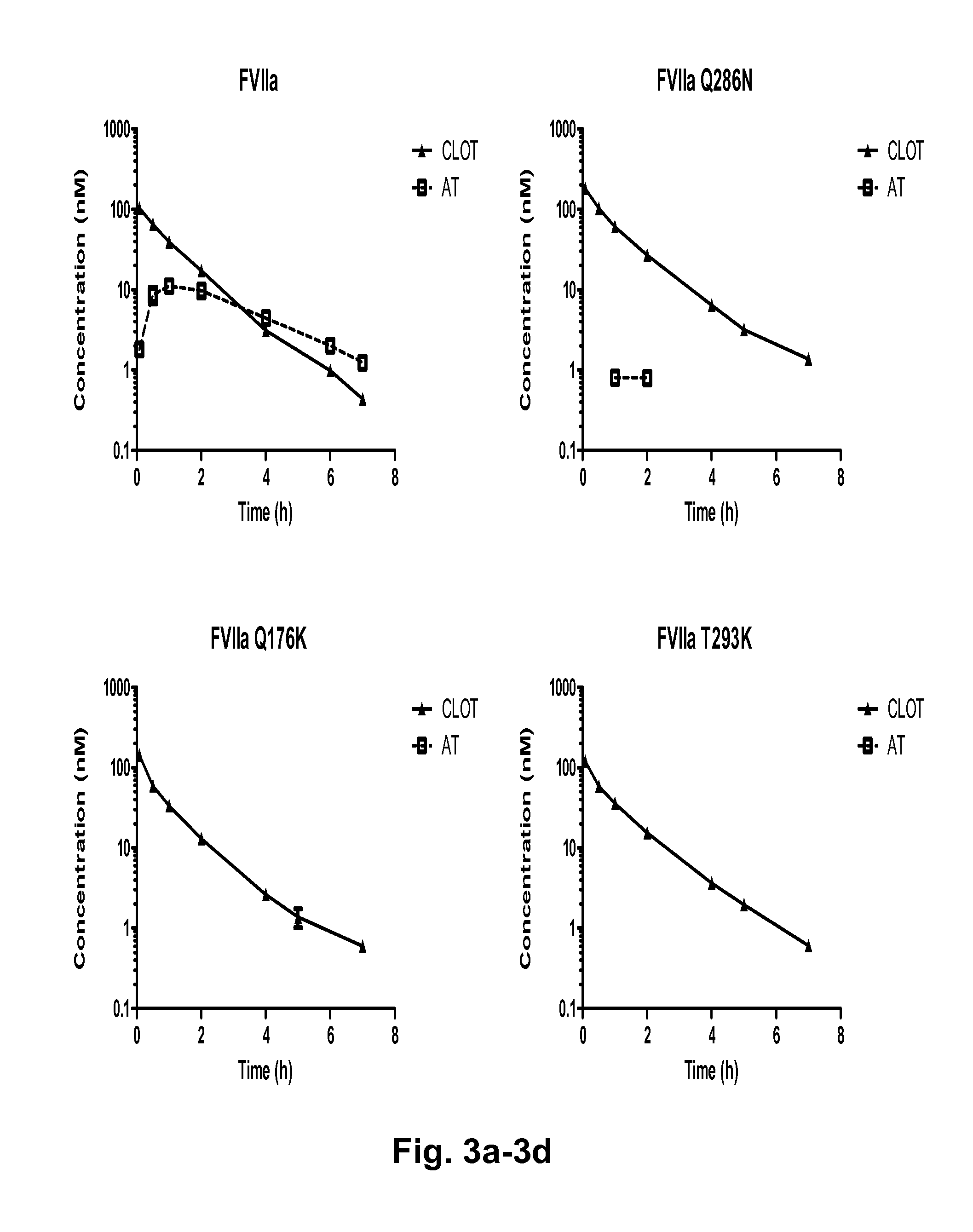Coagulation factor vii polypeptides
a technology of coagulation factor and polypeptide, which is applied in the direction of peptide/protein ingredients, drug compositions, extracellular fluid disorder, etc., can solve the problems of reducing the production of thrombin, which is necessary for coagulation, loose unstable primary plug of platelets, etc., to prolong the functional half-life of in vivo, improve current treatment options, and improve therapeutic utility
- Summary
- Abstract
- Description
- Claims
- Application Information
AI Technical Summary
Benefits of technology
Problems solved by technology
Method used
Image
Examples
example 1
[0137]To map the FVIIa-antithrombin interaction, FVIIa variant libraries were designed in silico based on a structural model of the complex of FVIIa-antithrombin complex. The model shown in FIG. 1 was built using the published X-ray structure of FXa-antithrombin Michaelis complex as template (Johnson et al. 2006). FVIIa residues in close vicinity to antithrombin (the largest distance between FVIIa and antithrombin side chains was 12 Å) in the model were subject to mutagenesis. The first library was designed to explore the impact of conservative changes on human FVIIa binding to antithrombin. An alignment of FVII sequences from a variety of species (chimpanzee, dog, porcine, bovine, mouse, rat and rabbit) is shown in FIG. 2. A side chain in human FVIIa, in close vicinity to antithrombin, which in other species has a different side chain was mutated to that of the corresponding species. One example is the residue in position 286 being Gln in human FVII and Arg in porcine FVII. After s...
example 2
[0138]Mutations were introduced into a mammalian expression vector encoding FVII cDNA using a site directed mutagenesis PCR-based method using KOD Xtreme™ Hot Start DNA Polymerase from Novagen or QuickChange® Site-Directed Mutagenesis kit from Stratagene. The following expression vectors were used: pTT5 (Durocher et al. (2002) Nucleic Acid Res. 30(2):e9) for transfection of HEK293F and HKB11 cells; pQMCF from Icosagen (Estonia) for transfection of CHOEBNALT85; pZEM219b (Busby et al. (1991) J. Biol. Chem., 266:15286-15292) and pMPSVHE (Artelt et al. (1988) Gene 62:213-219) for transfection of CHO-K1; pLN174 (Persson et al. (1996) FEBS Lett., 385:241-243) for transfection of BHK cells. Primers were designed according to manufacturer's recommendations. Introduction of the desired mutations was verified by DNA sequencing (MWG Biotech, Germany).
example 3
[0139]The FVII variants were expressed either in Baby Hamster Kidney (BHK) cells, Freestyle™ 293-F human embryonic Kidney cells (HEK293F; Gibco by Life Technologies, Naerum, DK), HKB11 (a hybrid cell line of HEK293 and a human B cell line) cells (ATCC, LGC Standards AB, Boras, Sweden), Chinese Hamster Ovarian (CHOK1) cells, or CHO-EBNALT85 cells from Icosagen Cell Factory, Estonia.
[0140]BHK adherent cells were transfected with FVII variant constructs using GeneJuice® from Merck Millipore (Hellerup, Denmark), according to manufacturer's instructions for production of stable cell lines. Methotrexate (Sigma-Aldrich) was used as selection reagent. Stable cell lines were cultured in medium to large scale giving a total of 5 to 10 litre cell supernatant. Cells were cultured in incubators at 37° C., 5 or 8% CO2 in DMEM (Gibco by Life Technologies, Naerum, DK) supplemented with 2% (V / V) fetal calf serum (Gibco by Life Technologies, Naerum, DK), 1% (v / v) Pencillin / Steptomycin (Gibco by Life ...
PUM
 Login to View More
Login to View More Abstract
Description
Claims
Application Information
 Login to View More
Login to View More - R&D
- Intellectual Property
- Life Sciences
- Materials
- Tech Scout
- Unparalleled Data Quality
- Higher Quality Content
- 60% Fewer Hallucinations
Browse by: Latest US Patents, China's latest patents, Technical Efficacy Thesaurus, Application Domain, Technology Topic, Popular Technical Reports.
© 2025 PatSnap. All rights reserved.Legal|Privacy policy|Modern Slavery Act Transparency Statement|Sitemap|About US| Contact US: help@patsnap.com



